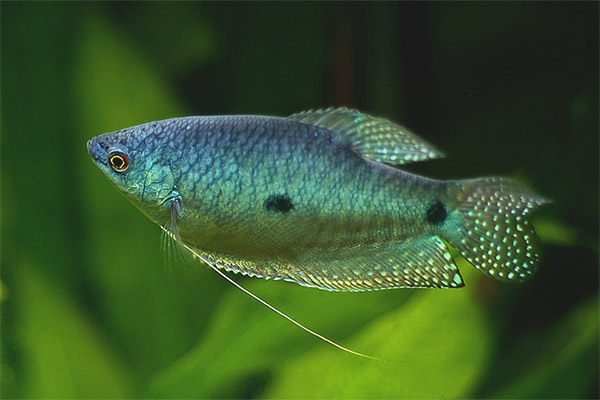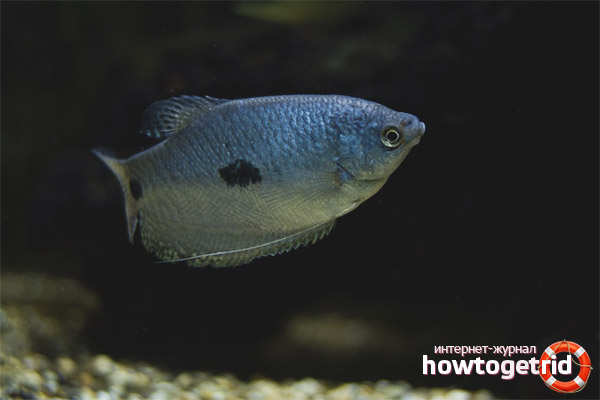The content of the article
The blue gourami is a very beautiful fish, which is also unpretentious in its care and maintenance. Another feature of it is the diversity of species, each of which has its own individual characteristics. Very beautiful color, interesting fins, which gourami literally touch on everything, as well as the need to breathe oxygen, gave these fish a very real popularity and high prevalence.
Gourami - rather big fish, they grow up to 15 centimeters in length. In aquariums, individuals are somewhat smaller in size. Young pets suitable small capacity for habitat, it will be enough volume of 40 liters. Adult fish will need to be placed in a larger tank. Males gourami - slightly aggressive individuals, so in the aquarium you need to equip shelters for females and fish of other species. Perfect for this purpose, various decorative items and plants.
Distribution under natural conditions
The second name of the fish described is Sumatran gourami. These fish are distributed mainly in south-east Asia. The habitat of gourami is very wide, they can be found in China, Sumatra, Vietnam and Cambodia. These fish live in lowlands filled with water. As a rule, these include stable waters or water bodies with a slow flow, for example, swamps, ditches, streams, irrigation systems and rice fields. The habitats of gourami are without any current, but at the same time with abundant amounts of vegetation. During periods when the humidity is too high, for example, in the season of high precipitation, gourami move to the spill area of the rivers, and after the season they return to their former territories. Under natural conditions, gourami use bioplankton and insects for food.
It is very interesting that gourami are one of the few fish that are capable of catching insects that fly above the water surface. They release a stream of water from their mouths and knock insects out of it, and then catch their prey.
Appearance gourami
What to feed?
Blue gourami - a fish that feeds on almost everything. In nature, they mainly eat insects, various plankton, as well as larvae. When placed in aquarium tanks, these fish can be given any kind of food: live, dry, frozen and artificial.The basis of the menu, you can put dry food, various flakes and granules. As a supplement to the diet, you can use frozen food - insects, motels, artemia, coretru and tubule. Any of the food presented gourami eat absolutely calmly. The only thing you should pay attention to is gourami small mouth, and therefore they need to chop the food very finely.
Conditions for content
As mentioned earlier, young fish can be maintained and grown in a small aquarium, up to 40 liters. Adults need a larger capacity, approximately 80 liters. Since gurs for breathing use oxygen from the atmosphere, it is necessary to ensure a minimal difference between the temperature indices of water and air.
Fish of this species do not like the fluctuations of water, so the filtering system must be installed so that it does not create currents in the aquarium. It is not necessary to install an aeration system, for gourami it is not so important.
Inside the aquarium you need to plant a fairly large number of plants. The fact is that gourami can be pugnacious and very aggressive. In this regard, the fish will need places to hide.
In general, indicators of water can be completely different, because gourami easily get used to different conditions. The most suitable temperature will be water in the range from 23 to 28 degrees. Acidity should be within 8.8 units, but not lower than 6. Water hardness up to 35 units.
Living with other fish
Young gourams can live very well in tanks with individuals of other species, while adult fish can seriously change their behavior. Males over time become quite aggressive, and therefore begin to provoke various skirmishes and fights. It is best to keep a pair of fish in one aquarium - a male and a female, but for the female you will definitely need to arrange various shelters. If you still decide to share your neighbors with gourami, the fish must be the same size, no less. This will reduce the number of conflicts. Since gourami is a fish that loves to hunt, it will easily catch and eat all the fry that will be present in the aquarium.
Sexual features
To distinguish between male and female in blue gourami is quite easy. This can be done by the appearance of the fin.In males, the fin located on the back has a long length and a pointed end. The female gourami fin on the back is small and rounded.
How to breed?
It is necessary to increase the temperature indicators of water to 26 degrees. At this point, the male will arrange the nest on the water surface. It uses for this purpose traditionally vegetable components and air bubbles. After the nest is fully prepared, the male begins the mating game. In this case, the male representative draws the attention of his second half to himself, pursues her and gradually leads to the nest.When a female is ready, a representative of a strong half envelops her with his body and literally squeezes the eggs out of her, at the same time fertilizing them. Such actions are performed several times, the female can lay up to eight hundred larvae. Eggs go up to the aquarium and enter the nest.
Video: blue gourami (Trichogaster trichopterus sumatranus)












To send